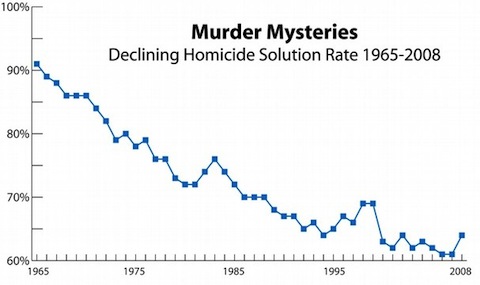
There is great wisdom to be gleaned from studying anomalies, which is why the El Paso Police Department’s homicide unit deserves our attention. It is the rare squad that appears to be solving an ever-greater percentage of its cases, thereby defying the nationwide trend illustrated in the graph above:
Since 2004, unit detectives have investigated 106 slayings and solved all but four of them. Two homicides this year have yet to result in an arrest. However, detectives said they’re closing in on possible suspects in those killings.
According to FBI statistics, 91 percent of the murders investigated by the Police Department between 2000 and 2008 have been solved. On average since 1980, the department has had an 87 percent homicide clearance rate, compared with the national average of 63 percent.
The article goes on to credit the detectives’ tireless dedication, but that’s probably not a very good explanation—plenty of city’s have homicide investigators who give it their all. My hunch is that there is something about the nature of the cases in El Paso that makes them easier to solve. The story does flick at the fact that the city’s cops enjoy an unusual amount of cooperation from witnesses, though it doesn’t offer a convincing reason as to why that’s the case. Do El Paso residents feel more immune to intimidation than people in comparably sized cities? And if so, is that a product of a social mechanism that condemns omertà? Someone with criminological chops far greater than Microkhan’s, please shed some light.


Cabbage // Jun 14, 2011 at 10:10 am
I heard that the Chief of Police’s son is nicknamed “Encyclopedia”…
Brendan I. Koerner // Jun 14, 2011 at 10:12 am
@Cabbage: Bugs Meany can only commit so many murders, though.
Captured Shadow // Jun 14, 2011 at 12:15 pm
Round up the usual suspects……
Any chance they are not too picky about getting the RIGHT murderer?
Brendan I. Koerner // Jun 14, 2011 at 12:48 pm
@Captured Shadow: Y’know, that did occur to me. Not an easy thing to assess–the conviction rate probably doesn’t yield too many clues, since so many cases probably end up in plea bargains. I’d like to know more about the typical case in El Paso–gang-related? Domestic? Wish the reporter had pursued that angle a good deal more.
Jordan // Jun 15, 2011 at 1:15 am
Part of me wonders if there’s a peculiar feedback loop going on. As crime rates fall, police departments may be devoting fewer resources to their homicide units. If they get the budgets wrong, they may not be able to deal with what crime still exists.
Brendan I. Koerner // Jun 15, 2011 at 9:48 am
@Jordan: The big theory on the declining clearance rates seems to be that cops have greatly reduced the sorts of killings that are easily solved–particularly those involving poorly planned (and often drug-related) robberies, as well as domestic cases. What remains (at least according to the theory) are gang-related murders in which witnesses and intelligence are hard to come by.
Should be noted, of course, that a lot of drug-related violence has simply moved south of the border. It’s the balloon effect–you push down in one area, and all the air flees to another.
Sara Mayeux // Jun 15, 2011 at 3:48 pm
Some scattered thoughts:
I don’t know if this explains the size of the discrepancy, but El Paso has very low crime rates overall, which maybe means the detectives have more manageable caseloads? I’d guess there are cases in other cities that don’t get solved because they just don’t really get investigated thoroughly. This is speculation, though.
I’d also guess that being right on the border and having a long history of interactions between El Paso and Mexico maybe helps — I’d guess there isn’t the same level of distrust/fear between the police and Mexican communities that you see in, say, Arizona. Here is an old but interesting article on El Paso’s resistance to harsh border security measures:
http://www.washingtonpost.com/wp-dyn/content/article/2007/08/20/AR2007082002022.html
All that said, I also wonder sometimes if El Paso’s crime stats are artificially low because it’s right across the border from one of the world’s deadliest cities — if you’re in the El Paso area, you’d probably commit your calculated gang-related murders in Juarez (whereas, say, if you’re in Los Angeles it’s maybe not worth the drive). So it might be more useful to consider El Paso in its regional (transnational) context. Given the militarization of the border, I don’t know how much people actually go back and forth between El Paso and Juarez anymore, but I would be interested in reading some good reporting on how exactly the “balloon effect” you mention plays out on the ground, among, say, drug organizations. Here’s an article on Juarez from 2010 that I remember as being good:
http://bostonreview.net/BR35.4/hill.php